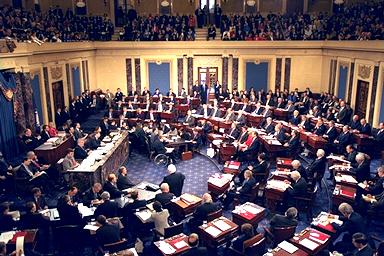As election day draws near, it’s becoming more and more likely that Hillary Clinton will win by a historic margin over her Republican opponent. While this would undoubtedly be a severe blow to the struggling party, much of what the GOP stands to lose has nothing to do with the presidential election. Instead, what many Republican elites are worrying about is the nearly 65 percent chance that Democrats will retake the Senate, as reported by FiveThirtyEight.
This presents an issue that few analysts are willing to even acknowledge.
In politics, there is a principle referred to as “presidential coattails,” which means that legislators in tight races often benefit from their party winning the national election. Historically, whenever a new candidate wins the Oval Office, the odds increase for Congress to reflect this change in ideological leadership. Although many race polls haven’t been conducted yet, Donald Trump’s campaign appears to be impacting down-ballot Republicans nationwide.
In 2012, President Obama successfully won reelection for a second term against Governor Mitt Romney. While this was a victory for Democrats, what ensued was a takeover by the Republican party in the Senate. Yet, as we quickly approach November 8th, only 30 of these Republican seats are not up for reelection. Compare this to the Democrat’s 36 “safe” seats, and one can see an immediate advantage for Clinton’s party: the GOP stands to lose nearly 24 seats while the Democrats can only lose 10. So where does this put each party? Using FiveThirtyEight’s prediction, there is the potential that November 8th will restore the Democrats’ majority in the senate, with a total of 51 seats.
This loss of a Senate majority might be significantly more important that Trump losing the election.
While RealClearPolitics predicts that Clinton will command an electoral landslide, the implosion of Trump’s campaign will play a larger role in senate races. Indeed, the foundation of Trump’s platform is hatred and bigotry. Whether it be his calls for banning Muslims from entering the country or allegations of his sexual misconduct by numerous women, Trump has tarnished the Republican party. Combined with Clinton’s chances of winning the election, Republican senators are desperately attempting to distance themselves from the GOP candidate.
Why is it so important to Republicans to maintain control of the Senate?
The answer to this question is has to do with the Supreme Court, which currently has a seat that needs to be filled, which was opened in the wake of Justice Scalia’s passing. The sole governmental organization which oversees this process is the Senate. While President Obama has nominated a judge to fill this position, Republicans have refused to hold any hearings before the election. However, if Democrats are able to successfully win a majority in the Senate, Clinton would be able to nominate any judge to fill this vacancy.
Arguably, Supreme Court Justices are able to affect the greatest changes in public policy, as they are insulated from public opinion. While currently only one spot is open on the Court, Justices Ginsburg, Breyer and Kennedy are all nearly 80 years old. Since 1971, the average age of retirement for a Supreme Court justice has been roughly 79 years old. Thus, by the end of Clinton’s first term, she could be responsible for appointing nearly four justices. It’s this monumental possible shift in the Court’s ideology that has many Republicans worrying about Trump’s influence on Senate races. A loss of the Senate majority would prove to be catastrophic for the GOP.
Although current polls suggest that Democrats stand the best chance of winning Senate majority, there is a caveat to this prediction: many of these races are extremely tight. It’s impossible to accurately assess how the election will swing, especially with many registered voters going unpolled prior to casting ballots. It will be intriguing to see if Republicans can rally enough support to keep their majority. If not, one can expect to see a historic shift within the Supreme Court, overseen by our nation’s first female president.


